
|
Deaths Scenes 1971 |
| Film Title/Year and Description | ||||||||
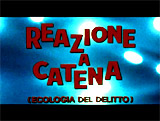
|
A Bay of Blood (1971, It.) (aka Reazione a Catena, or Ecology of a Crime, or Twitch of the Death Nerve) Mario Bava's influential and controversial, bloody Italian horror-thriller was the grandfather of all slasher films. [Note: Friday the 13th, Part 2 (1981) reportedly copied some of its death scenes or murderous situations verbatim from this film, as did Halloween (1978).] It featured many deadly characters (five murderers), multiple victims and thirteen gruesome murders - all related to the acquisition-inheritance of the deed to some lake-bayfront property. The most memorable murders/deaths in the film were a machete to the face, and a spear impalement of two lovers, Duke (Guido Boccaccini) and Denise (Paola Rubens) during love-making. The spear was first seen protruding into view, and then coming down hard through the female's back, into the male, and out the other side of the bed mattress.
And then in the film's ironic final surprise shocking ending scene, smiling and congratulatory parents Albert (Luigi Pistilli) and Renata (Claudine Auger) were talking about how they had eliminated all inheritance competitors for the bayside property, and that there were no other living heirs:
The two hugged each other as they stood at the trunk of their Mercedes (Albert: "All's well that ends well"), and then a young boy's voice called out: "Mommy, Daddy!" - with the view of the end of a double-barreled shot-gun pointed at them. A smoky blast from the end of the gun signaled that they had been abruptly shot to death. A zoom-out showed the two parents dead on the ground. As the next blurry shot came into focus, it showed their two young children standing at an opened RV trailer window - Son (uncredited Renato Cestie) - with a shotgun in his hands, and Daughter (uncredited Nicoletta Elmi) - a red-headed, pig-tailed girl next to him.
They ran down to the bay to play as the film ended with a soundtrack of a happy chorus of "yeah-yeahs." |
  Machete In Face   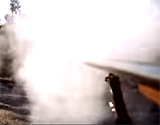  Murdered Parents  The Son (With Shotgun) and Daughter 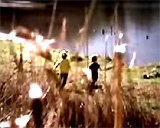
|
||||||
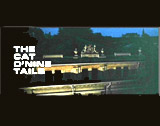
|
The Cat O'Nine Tails (1971, It.) (aka Il Gatto a Nove Code) This was one of the earlier Italian horror thrillers from Dario Argento, and he claimed it was one of his "least favorite" films - although it had an impressive score by Ennio Morricone and some effective Hitchcockian set-pieces. In the film's conclusion, the murderer - a deranged lab scientist Dr. Casoni (Aldo Reggiani) (with a rare XYY chromosome, meaning that he possessed criminal tendencies) - was pushed by enraged, stabbed reporter Carlo Giordani (James Franciscus) into a skylight on the rooftop of the Terzi Genetic Research Institute. He plunged down a deep elevator shaft - with the cables sliding through his bloody, smoldering, and shredding hands. Also earlier, there was the 'accidental' death of lab geneticist Dr. Calabresi (Carlo Alighiero) who was pushed in front of an oncoming train - a victim of foul play. |
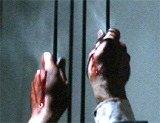 Elevator Shaft Death 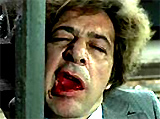 Train Death |
||||||
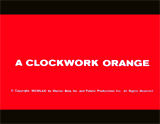
|
Stanley Kubrick's randomly ultra-violent, over-indulgent, graphically-stylized film of the near dystopic future was about fascist social conditioning and free will, adapted from Anthony Burgess' novel. One of the more controversial scenes was of a gigantic penis sculpture being used as a murder weapon by a gang of juvenile delinquent droogs on a female victim. One of young punk Alex's (Malcolm McDowell) early assault and robbery victims was located at an almost-deserted, isolated Woodmere Health Farm outside of town "owned by this like very rich ptitsa who lives there with her cats." It was a carpeted facility, wall-papered with gigantic, modern pornographic art (lewd scenes of sexual intensity and bondage), and decorated with garish, decadent art objects. The facility's manager was wiry, introverted red-haired Englishwoman Miss Weathers, known as the 'Cat Lady' (Miriam Karlin), who wore an emerald-colored leotard. She was exercising on the floor surrounded by dozens of cats when she heard knocking, but refused to answer. Alex sneakily entered through a window on the second floor, and confronted her while grinning: "Hi-hi-hi-hi there!" He called her giant phallus artifact "naughty, naughty, naughty. You filthy old soomka." When he rocked her giant, obscene phallus sculpture on its testicles, she screamed: "Leave that alone! Don't touch it! It's a very important work of art." The Catlady retaliated by picking up a bust of his beloved Beethoven and rushed at him - they dueled each other with antagonistic weapons. He held her off with the oversized phallus, while she thrust the small bust of Beethoven at him. When she went down on the floor, Alex raised the Beethoven sculpture above her and plunged it down into her - filmed from a low angle. As she screamed, a close-up of a mouth within another open mouth (from one of the pop paintings in the rooms) flashed on-screen with other dismembered body parts in an orgy of modern art. Alex left her senseless and beaten on the floor, mortally wounded by her own sculpture-turned-weapon, when he heard sounds of distant police sirens. |
   Alex With Penis Sculpture Raised Above Head - Used as Murder Weapon on Cat Lady 
|
||||||

|
Daughters of Darkness (1971, Belg.) (aka La Rouge Aux Levres, or Blood on the Lips) This highly-stylized, erotic, art-house vampire film was based upon Sheridan Le Fanu's lesbian vampire tale Camilla. It told about a newlywed, honeymooning 1970s couple who were staying at a deserted seaside hotel in Belgium during the off-season:
Newly-arrived guests included:
The Countess described the other wedded couple guests as: "so perfect, so good-looking, so sweet." Ultimately, the predatory Countess had her sights on replacing Stefan's wife with herself, and she set about to seduce Valerie. To accomplish her objective, she also ordered Ilona to seduce Stefan, as a distraction.
As Stefan took a shower, a stark-naked Ilona peered at him - with a voluptuous pose and inviting red lips (seen in a zooming close-up). When he turned and noticed her, he playfully pulled her naked into the water, but as a vampire and knowing what water would do to her, she struggled against him. During an intense scuffle, she screamed and grabbed his sharp razor-blade in her hand, bloodied herself, and then fell on the sharp instrument - killing herself, to make it appear that she was humanly mortal. |
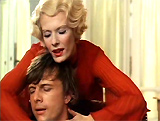 The Countess Seducing Stefan 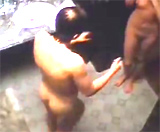 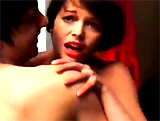 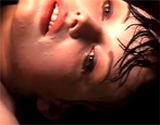 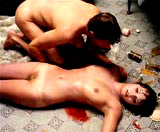  Death of Vampire Ilona in the Water and From Impalement |
||||||
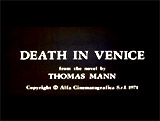
|
Death in Venice (1971, It.) (aka Morte a Venezia) In director Luchino Visconti's stylistically lavish adaptation of Thomas Mann's novel - a tale of sexual obsession, it concluded with a beautifully shot, quiet and lonely death scene. Aging, avant-garde German composer Gustav von Aschenbach (Dirk Bogarde), during a visit to Venice, slumped dead on a deck chair on a Venetian beach (accompanied by music from a Gustav Mahler symphony), close to the Grand Hôtel des Bains on the Lido where he was staying. The feverish Gustav died of heart failure (and possibly from the cholera epidemic which was gripping the city - an allegory of corruption) - or a possible suicide - with dark hair dye dripping down his sweaty, chalk-white face, as he lounged on a solitary beach chair. He had been lovingly watching an angelic-looking teenaged Polish boy named Tadzio (Bjorn Andresen) on the beach, also on vacation with his family, who was on the beach wrestling with an Italian youth. He then observed as Tadzio waded out into the water and pointed out toward the horizon of the pink-tinged ocean - Gustav's dying expression mixed contentment, pain, and acceptance as he also reached out his hand toward the unattainable boy before his death.
The image of heavy dark make-up running down his cheeks as he succumbed was accompanied by the Adagietto from Gustav Mahler's Fifth Symphony. The last image was an extreme long-shot of his beach chair on a large deserted stretch of sand, when his body was found by other hotel guests and carried away by workers. |
 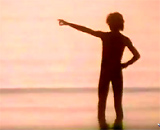 
|
||||||
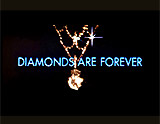
|
In this 7th Bond film, smuggled diamonds (acquired by a smuggling ring) were to be installed in a space-laser satellite, financed by Howard Hughes-like billionaire tycoon Willard Whyte (Jimmy Dean). The laser-equipped space satellite, set to destroy the nuclear arsenals of world powers, would be used to extort money from the super-powers (the highest bidder would acquire nuclear supremacy). The head of a ring of international diamond smugglers was malicious and recurring nemesis Ernst Stavro Blofeld (Charles Gray). Two of SPECTRE villain Blofeld's cold-blooded henchmen were continually doing his dirty work - both were sinister and gay assassins:
They murdered anyone who came into contact with smuggled diamonds from South Africa on their way through Europe to LA and Las Vegas. They followed each killing with a witticism. In the film's climactic conclusion, after Blofeld had been defeated, they were disguised as waiters on the Canberra cruise ship carrying Bond (Sean Connery) and diamond smuggler Tiffany Case (Jill St. John) back to England. They brought in a gourmet meal of food and drink (to be topped off with dessert cake, La Bombe Surprise!) - reportedly compliments of billionaire entrepreneur Willard Whyte (Jimmy Dean). Bond was tipped off to the pretension ("smelled a rat") by Wint's familiar after-shave smell and his own clever knowledge of wines. As Bond was being choked and held from behind by Wint, Kidd lunged menacingly at him with two flaming shish kabobs. Bond turned him into a human fireball by dousing him with the contents of a broken bottle of brandy. Kidd was forced to race to the yacht's railing and jump overboard (and presumably drown) to extinguish the flames. Wint's demise came next. Bond tightly pulled Wint's tuxedo jacket up between his legs, attached the ticking time bomb surprise (hidden in the cake) to the tails of it, and somersault-flipped him off the deck where the bomb exploded in mid-air. Bond joked:
|
 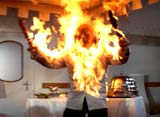 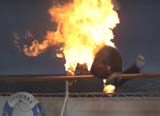 Death of Mr. Kidd  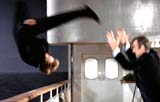 Death of Mr. Wint |
||||||
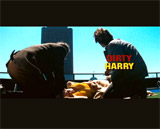
|
A very satisfying and justified execution sequence occurred at the conclusion of this popular "Dirty Harry" film. In a rock quarry, vengeful vigilante lawman "Dirty Harry" Callahan (Clint Eastwood) finally killed psycho-sadist Scorpio (Andy Robinson) with his .44 Magnum after repeating his earlier litany (to the bank robber) as he stood above him during their final showdown. Gritting both his teeth and jaw, Callahan gave him a grim choice - surrender, or gamble ("feel lucky") by reaching for a gun, hoping that Harry was out of ammunition:
The hippie psycho-sadist made his choice and reached for the gun - but there was one more bullet in Harry's gun, and Scorpio was executed and shot dead - in cold blood. His body was propelled backward into the small lake. Callahan walked to the edge of the wooden platform above the water to gaze down at the murderer's bloodied corpse floating and slowly sinking below him. After having found retribution his own extra-legal way by exterminating the heartless and sick terrorist, without following bureaucratic police procedures, he thoughtfully hurled his police badge (Inspector 2211, SF Police) into the stagnant pond with the body and then walked away. Knowing that he would ultimately be reprimanded and fired for his action, the unrepentant Harry 'threw away' the symbol of his future police career in disgust. [Note: This scene paid homage to the final scene of High Noon (1952) when the lone Marshal contemptuously discarded his badge in the dust after being betrayed by the entire Western community.] |
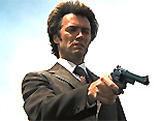 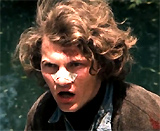 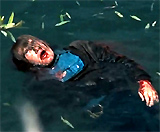 'Dirty' Harry's Killing of Scorpio  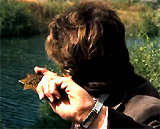 'Dirty' Harry Discarding His SFPD Badge |
||||||
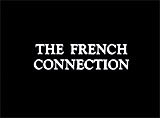
|
Director William Friedkin's brilliant, true-to-life, fast-paced, brutally-realistic police/crime film, a Best Picture winner, was about the passionate and obsessive pursuit of drug pushers in New York City by a pair of narcotics cops:
At the end of the film's famous car chase after the NYC subway train crashed [photographed with the train moving away from the camera - and then reversed], murderous drug-ring sniper Pierre Nicoli (Marcel Bozzuffi) escaped from the wreckage, believing that he was free of Doyle. But Doyle gunned him down at the top of the elevated train depot stairs - the iconic image became the famous promotional still used to advertise the film on posters. The poster added this line to the image: "Doyle is bad news - but a good cop." |
 Iconic Death Pose |
||||||
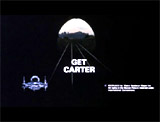
|
Get Carter (1971, UK) London gangster Jack Carter (Michael Caine) had just finished avenging his brother's murder and executing the last of the perpetrators, Eric Paice (Ian Hendry), after forcing him to drink a bottle of alcohol, butting his skull with a shotgun, and dumping his body in the sea. As he was walking along the deserted, blackened beach, he was whistling and relieved that his killing days appeared over. Carter was contemplating ending a life of brutality and violence (by throwing his shotgun into the water and moving abroad), when he was shockingly and depressingly murdered by a single shot in the forehead from sniper fire - from a man named "J" (identified from his signet ring near the trigger, in close-up). The waves lapped around his corpse near the surf line, as the sniper packed up his killing gear and walked off.
|
 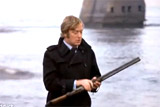 Jack Carter (Michael Caine)  Sniper's Ring |
||||||
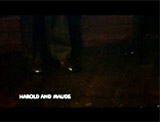
|
Harold and Maude (1971) Hal Ashby's cult classic black comedy/romance was notable for its dark humor for the many elaborately-faked or staged suicides:
They were acted out by 20 year old, troubled, death-obsessed introvert and rich kid Harold (Bud Cort) to shock, scare and seek attention from his desperate, widowed, socialite domineering mother Mrs. Chasen (Vivian Pickles). Her typical reaction was:
In the film's most incredible and shocking scene, Harold performed a faked harakiri in front of his drama student date Sunshine Doré (Ellen Geer) - who also unwittingly acted out the tragic scene from Romeo and Juliet - and stabbed herself to death! |
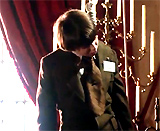 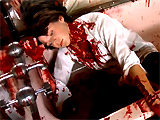 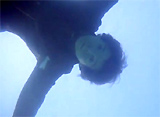 Harold's Suicidal Pranks 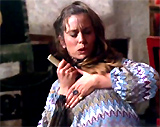 Romeo and Juliet Re-Enacted |
||||||
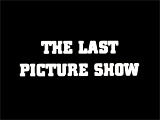
|
Director Peter Bogdanovich's evocative and bittersweet slice-of-life 'picture show' and character study followed various episodes (occurring in one year) in the lives of numerous characters who lived in the town of Anarene in northwestern Texas - a dusty, wind-swept, one-horse, declining small-town that was on the verge of being forgotten in the early 1950s. Near the end of the film, Sonny Crawford (Timothy Bottoms) entered the town's poolhall to light a fire, but then heard a horn and the screeching noise of the brakes and tires of a truck out on the main road. As he walked toward the square, he saw people standing by the side of a big cattle truck. The camera assumed his point-of-view as he ran toward the scene of the accident, where he heard hereford yearlings bellowing in the filled-to-capacity truck. He noticed a broom lying on the pavement in front of the crowd - identifying the victim as his own dim-witted and mute friend Billy (Samuel Bottoms). Cowboys, the trucker, and other townsfolk were gathered around Billy's body after he had been struck dead. Although Sonny reacted with numb horror to his friend's senseless and tragic death, he listened as the men spoke with indifference and callousness:
Devastated by the tragedy, an anguished Sonny screamed and yelled at the apathetic onlookers, with the moving line:
He scooped up Billy's limp body, now silenced forever, and dragged it over to the sidewalk in front of the picture show. He removed his letter jacket and lovingly covered Billy with it, and then picked up Billy's cap and placed it next to him. He was numbed by the shock of grief. [Note: This scene paid homage to the final one in Nicholas Ray's Rebel Without a Cause (1955).] |
 Sonny Crawford Coming Upon Accident Scene   Tragic Death of Billy - Run Over by Truck 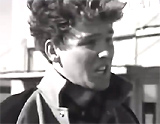 Sonny: "He was sweepin'..." 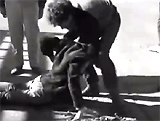 Picking Up His Friend's Body |
||||||
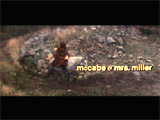
|
In director Robert Altman's revisionist western set in the harsh wintry Pacific Northwest at the turn of the century, heavy-drinking, two-bit gambler and 'bordello'-house proprietor/businessman partner John Q. McCabe (Warren Beatty) (with a mysterious past) met his eventual demise. When de-romanticized, bearded, derby-hatted, suited McCabe unwisely turned down a corporate offer to buy the zinc mining operations and its financially-successful saloon (House of Fortune) and whorehouse (with classy prostitutes brought in from Seattle) in the fledgling, muddy frontier town of Presbyterian Church, the Harrison Shaughnessy mining company hired three sinister murderous bounty hunters to assassinate him. [Note: The final scene was a reworking of the conclusion of High Noon (1952).] At dawn, there was a long and tense cat-and-mouse stalking sequence from one end of the town to another. McCabe sought refuge in the church, but was ordered out by the minister, Mr. Elliott (Corey Fischer). From his hiding places, McCabe was able to outsmart the first gunfighter named the Kid (Manfred Schulz), a young blonde Dutch immigrant punk, by shooting him in the back (he died in a barrel of water), but McCabe was shot in the leg and abdomen. He shot the next bounty hunter, a half breed (Jace Van Der Veen), through a store window, and the seriously wounded man crawled a few steps before dying in the snow. When McCabe was shot in the back by the third arch-villain bounty hunter Dog Butler (Hugh Millais) who was carrying a single-shot elephant blunderbuss gun, McCabe played dead and laid on his back in the snow. He then killed the giant, mustached Butler at point-blank range (with his hidden derringer, the one he legendarily claimed had shot Bill Roundtree) by a shot to the forehead when he approached. But the outnumbered, outmatched, and weakened McCabe found that he had been mortally-wounded during the climactic standoff and showdown in the bitter cold. He bled to death unnoticed, forgotten, silent and alone in deep falling and blowing snow as he staggered to get indoors. His face and eyes were covered with snow and ice crystals. Jubilant cheers were heard from the townsfolk (prospectors, whores, etc.) who had been preoccupied with putting out a church fire accidentally started by one of the killers. (When he was seeking McCabe, Butler blasted the minister with his elephant-gun, and his dropped oil lantern started the fire.) At the same time, McCabe's jaded, mercenary, opium-addicted Cockney madam and business partner Constance Miller (Julie Christie) was withdrawn and oblivious as she drifted off in a drug deluded state in the Chinese section of town, while fondling a marble egg in her hand. |
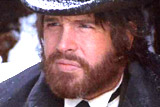  McCabe Playing Dead  Death of Butler 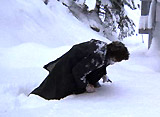  McCabe Mortally Wounded and Dying in Snow 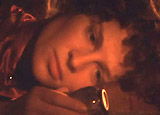 Drugged-State for Mrs. Miller |
||||||
(chronological by film title) Intro | 1915-1929 | 1930-1933 | 1934-1938 | 1939 | 1940-1942 | 1943-1945 | 1946-1947 | 1948-1949 1950-1952 | 1953-1955 | 1956-1957 | 1958-1959 1960-1961 | 1962-1963 | 1964-1966 | 1967-1968 | 1969-1970 1971 | 1972 | 1973 | 1974 | 1975 | 1976 | 1977-1978 | 1979 1980 | 1981 | 1982 | 1983 | 1984 | 1985 | 1986 | 1987 | 1987 | 1988 | 1989 1990 | 1991 | 1992 | 1993 | 1994 | 1994 | 1995 | 1995 | 1996 | 1997 | 1998 | 1998 | 1999 2000-2001 | 2002 | 2003 | 2004 | 2005 | 2006 | 2007 | 2008 | 2009 | 2010 | 2011 |